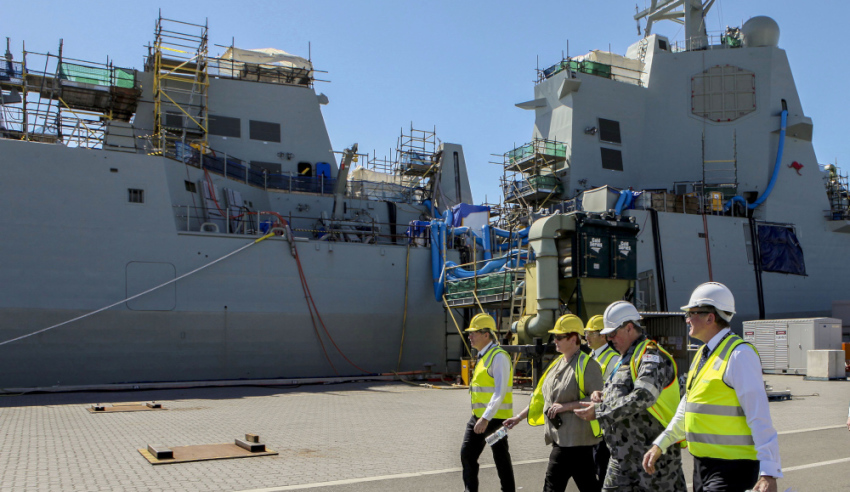While the development of Australia’s defence industry continues to go from strength-to-strength, debate and questions continue to swirl regarding the playing field the nation’s burgeoning industry finds itself in when competing with global primes, explains former RAN sailor Christopher Skinner.
To continue reading the rest of this article, please log in.
Create free account to get unlimited news articles and more!
Friday, 14 August was an auspicious day for Australian defence industry. The Senate economics references committee heard from no less than seven organisations, all but one of which had made submissions on Australia’s sovereign shipbuilding capability, and Australian Naval Infrastructure the last to appear by late invitation.
This made two important Defence publications came to my notice:
- A guidance document titled ‘Consideration of broader domestic economic benefits in procurement’ supporting the Commonwealth Procurement Rules, as announced by Minister for Defence Industry Melissa Price;
- The Defence Science and Technology [DST] Group publication OUTLOOK 2020-2021 Edition including foreword by Linda Reynolds, Minister for Defence, and opening interview with Chief Defence Scientist Professor Tanya Monro. Featured was the Defence Science and Technology Strategy 2030.
Minister Price made some important announcements regarding procurement economic benefits and is reported to have stated: "All potential suppliers must be treated equitably and must not be discriminated against on the basis of their size, location or ownership."
But that works both ways – if the overseas supplier is larger and their price is less then no preference can be made for a local company even if they could become the basis for sovereign industry capability essential for whole-of-life sustainment of the defence asset.
In the Senate hearings there was a clear message from all the witnesses that reform was needed to achieve sovereign defence capability but none of them had studied the newly minted procurement guidelines to assess how well the reform had been progressed.
Dr Marcus Hellyer appearing for the Australian Strategic Policy Institute in considering the naval shipbuilding industry was most concerned about the lead times for major programs to deliver their Attack Class submarines and Hunter Class ships.
He noted that the recent Defence Strategic Update had stressed the acknowledgement that we no longer could rely on 10 years’ warning time and hence there is an urgency in major defence programs that was not the case when the 2016 Defence White Paper was published.
Dr Hellyer went on to note that offshore patrol vessels [OPV] currently under construction in Osborne, SA, and Henderson WA, could be enhanced as arsenal ships with more guided weapons, an area that needs greater Australian industrial focus.
Similarly, we should be putting more effort into autonomous vehicles and treating submarines and ships as the platform from which they were launched, controlled during their mission employment and then recovered.
Shipbuilding was the major focus of the testimony from both the Australian Industry Group (AiG) and the Australian Industry and Defence Network (AIDN), who collaborated very well to present the views of both larger industrial enterprises and small and medium enterprises (SME). They agreed that for Australian industry capability and content (AIC) there needed to be clear objectives set and measurable targets included in contracts.
Several witnesses noted the difficulty of translating the AIC proposals from main contractors’ bids and proposals into contractual commitments that were measurable and auditable. Experience from the construction industry is that substitution of less expensive materials and subcontractors often occurs after contract award.
Department of Finance was clear that while they published the procurement guidelines the achievement of value for money criteria was the responsibility of the contracting body, in this case Defence.
The adherence to the guidelines was within the purview of the Australian National Audit Office (ANAO) but how that translated into specific AIC achievement was a matter for Defence to assess.
The good news from Defence is that an independent audit program for AIC is being developed and is nearing completion. Neither AiG nor AIDN had been consulted in preparation of that program.
Another hopeful development is the review of the Centre for Defence Industry Capability (CDIC) is nearing completion and Minister Price has said that the findings from the review will be made public.
Both AiG and AIDN stressed that a major challenge to achieve sovereign defence industry capability was the size and makeup of the workforce from apprentices all the way to design engineers and skilled tradespeople.
Defence witnesses gave a further insight into the submarine, OPV and frigate programs especially as they had embodied AIC objectives and achievements. One in particular caught my attention on the source selection for submarine main batteries.
The competition between an Australian proven supplier and an overseas alternative was justified on the basis that, notwithstanding that Australian PMB Defence had supported the Collins program in excellent fashion for three decades, the requirements for the Attack Class went further and beyond the experience of PMB even in their R&D programs.
The broader subject of R&D was mentioned by several witnesses and the shortfall in university research funding from the drop in overseas students could be an opportunity for Defence to sponsor more research there. The Defence S&T Strategy 2030 includes the statement ‘DST needs the growing network of university, research and industry partners…’ (OUTLOOK p24).
Overall then, the Senate hearing foreshadowed some of the issues that the updated procurement guidelines is intended to address. Current major programs will become subject to more searching audit but that won’t change the current contracts.
Fortunately the future submarine and frigate construction contracts are still to come and by then the AIC process should be working more effectively with greater certainty for industry – large and small.
Christopher Skinner served 30 years in the RAN at sea in SEATO deployment based in Singapore, the Vietnam War and surveillance in the north-west Indian Ocean. He is a councillor of the Australian Institute of International Affairs, NSW division.

 Login
Login







